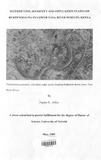Distribution, diversity and population status of herpetofauna in Lower Tana river forests, Kenya
Abstract
A study of the herpetofauna of lower Tana River forests was conducted between
September 2007 and May 2008, to determine the community structure and threats of the
protected and unprotected forest patches, with a view to improving habitat conservation
and management. Standardized methods (a time-limited search, traps with drift fences
and night transects) as well as opportunistic visual encounter survey were used for
herpetofauna survey. A questionnaire was also used to assess the cultural significance
and threats to the herpetofauna. Species richness (S) and Shannon- Wiener's diversity
index (Hi) were used for comparisons amongst forest fragments. One-way ANOV A test
was used to test for differences in the mean values of habitat characteristics within sites,
among forests and herpetofaunal species richness, abundance and diversity among the
three forests. Two sample t-test was used for differences in the mean values of
herpetofaunal species richness, abundance and diversity between the wet season and dry
season. Regression analysis was used to assess relationship between habitat
characteristics and herpetofaunal species richness, abundance and diversity. A total of 56
species were recorded of which 7 amphibian and 17 reptile species were recorded for the
first time in this region. Habitat characteristics (leaf litter cover, percent canopy cover,
soil pH, tree density, ambient temperature, percent vegetation cover) differed
significantly (p < 0.05) within sites in the forests. However, the same habitat
characteristics did not differ significantly (p> 0.05) across the forests. Herpetofaunal
species abundance and diversity did not differ significantly (p > 0.05) between the dry
and wet season
Similarly, amphibian and lizard species abundance and diversity did not differ
significantly (p > 0.05) across the forests, except for snakes (p < 0.05). There was no
significant relationship between habitat characteristics and herpetofaunal species
abundance and diversity (p > 0.05). The study confirmed that the lower Tana River
forests surveyed supported a moderately rich herpetofauna which is characteristic of
coastal forests. It also confirmed that the major threats to herpetofauna were forest
destruction through burning and clearing for agriculture. It also detected seasonal
variability in the abundance and diversity of herpetofauna in these forests. Species found
within the forests were generally similar, reflecting similarity in forest habitat structure.
Amphibian species abundance, richness and diversity were lower in disturbed than in
protected forest fragments. This study provided crucial information in establishing the
conservation status of herpetofauna of the lower Tana River forests. A study of the
offtake of crocodiles and the cost-benefit analysis of their utilization by the local
communities is recommended.
Citation
Degree of Master of ScienceSponsorhip
University of NairobiPublisher
University of Nairobi School of Biological Sciences

